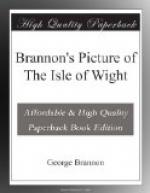* * * * *
WEST COWES.
>>_The transient visitor here should immediately inquire for the_ PARADE—pass by the CASTLE on the beach, to the bathing-machines—retrograde by the carriage-road under the NEW CHURCH—mount the hill at the back of the Castle—reach the OLD CHURCH, which is contiguous to NORTHWOOD PARK—and then return, to cross over to E. Cowes.
* * * * *
The decided advantages of Cowes are ... its excellent shore for bathing—and its safe and commodious harbour—which recommend it strongly as a fashionable watering-place, and the resort of gentlemen fond of aquatic amusements.
The appearance of this town from the water, particularly when approached by the passage from Southampton, is extremely pleasing; as the acclivity of the hill on which it stands is sufficiently bold to admit of the houses being seen above each other, as if built on a succession of terraces, while their starting formality is charmingly relieved by the intervening shrubberies and groups of lofty trees. To a stranger however, who may confine his walk to the streets just where he lands, this favorable impression would be almost obliterated,—for they are both narrow and crowded: though in these respects there is some improvement the further he goes either to the east or the west; but it is near the Castle that he must look for the greatest share of united beauty and respectability. The truth is, the lower part near the quay is of course occupied by tradesmen, for the advantages of business, and convenient landing-places; and as their houses stand at the edge of the water, many parties prefer their lodgings to those in the more open quarters on the top of the hill,—and many of them are therefore elegantly furnished for letting.
* * * * *
THE PARADE affords a delightful promenade, being on the water’s edge. Here are several first-rate houses, standing at the foot of the steepest part of the hill, which is luxuriantly clothed with hanging shrubberies and several groups of majestic trees, presenting a perfectly unique picture of sylvan and marine beauty. The Royal Yacht-Club House, with its ample awning, and the very elegant Gothic villa of Sir John Hippesley, will be particularly noticed.
[Illustration: THE CASTLE, WEST COWES, ISLE OF WIGHT]
THE CASTLE stands westward of the Parade: but were it not for a small battery of eleven guns in front, the stranger might search in vain for a fabric which he could identify as “a Castle,” at least by any portion of its modernized architecture and surrounding embellishments. In fact, the original dwelling was a few years ago greatly enlarged—made a story higher—the open ground at the back inclosed (!)—with other alterations to render it a fit residence for nobility. It was built by king Henry VIII, about the same time as those at Sandown, Yarmouth, and Calshot, for the purpose of securing the coast against the then frequent attacks of pirates, as well as the more formidable invasions of the French.




